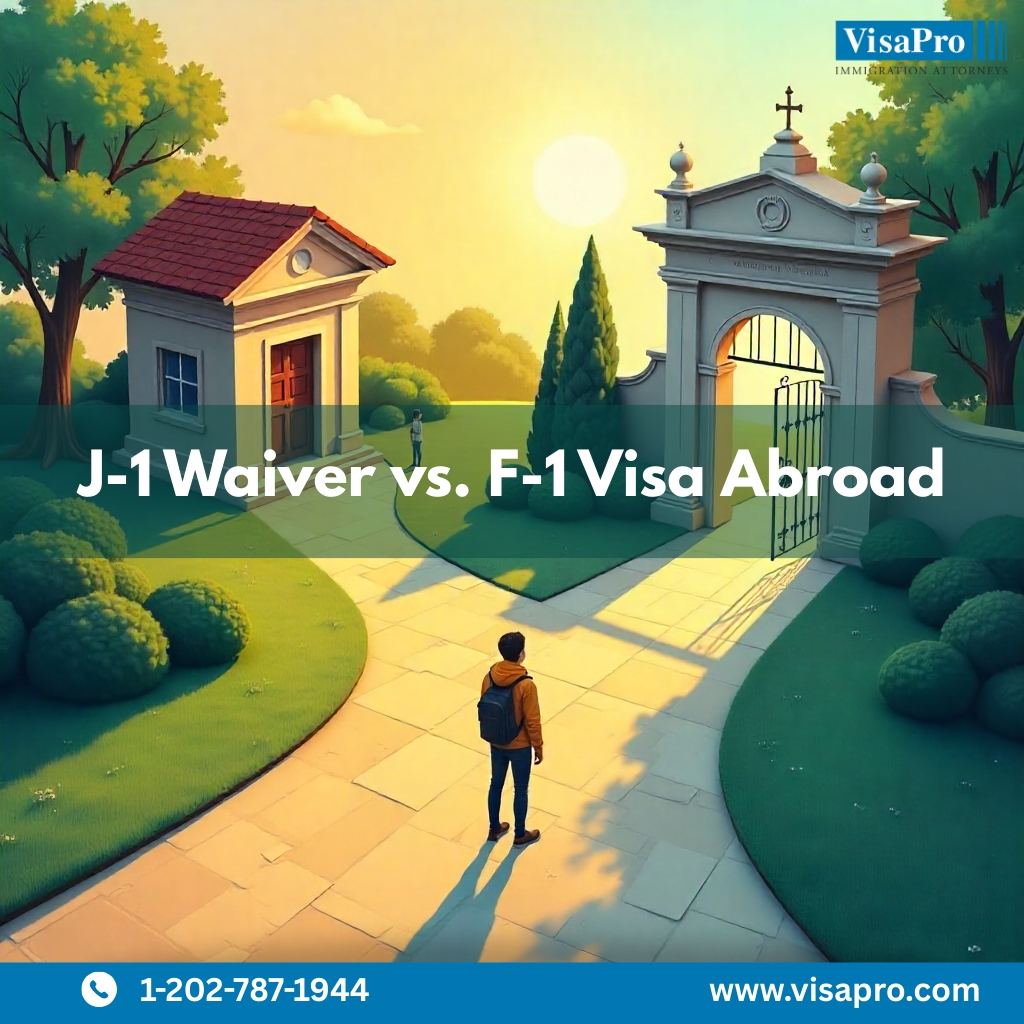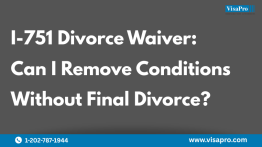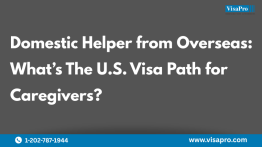Quick Summary:
Worried about switching from a J-1 to F-1 visa while staying legally in the U.S.? You’re not alone. Whether you’re confused about the 2-year home residency rule, facing a J-1 waiver denial, or unsure about your next move, this guide will walk you through your real options, step-by-step, with legal clarity and emotional reassurance.
Understanding Your Options: J-1 to F-1 Change of Status Explained
Yes, it is possible to change status from J-1 to F-1 if you meet specific eligibility requirements.
If you’re not subject to the 2-year home residency rule, you can apply for a change of status from J-1 to F-1 within the U.S. If you are subject to the rule, you’ll either need a waiver or must depart the U.S. and apply for an F-1 visa abroad.
Thousands of J-1 exchange visitors consider this change when their academic or training programs end, and they wish to continue studying in the U.S. But the process can be complex, and stressful, especially when dealing with waiver denials or visa interviews. Here’s what you need to know.

Are You Subject to the J-1 Two-Year Home Residency Requirement?
If you’re subject to the 2-year rule, you cannot change to F-1 status in the U.S. without a waiver.
The 2-year home residency requirement under INA 212(e) means you must return to your home country for two years or obtain a J-1 waiver before:
- applying for certain U.S. visas (H, K, L) or permanent residence, unless you obtain a waiver.
- Filing a change of status in the U.S. to any other visa category.
Who is this typical subject?
- J-1’s funded by U.S. or foreign governments.
- Those in skills-listed fields (designated by their home country).
- Medical trainees obtaining medical education or training.
Example:
Maria from the Philippines came to the U.S. for a public health research program on a J-1 visa funded by her government. Because her field is on the Philippines skills list and she received government funding, she is subject to the 2-year rule.
If you’re unsure about your status, check your DS-2019 and/or J-1 visa, or consult an immigration attorney.

Can You Apply for a J-1 Waiver While Still in the U.S.?
Yes, you can apply for a J-1 Waiver from within the U.S. through several legal options.
You don’t need to leave the country to start the waiver process. The most common type of J-1 waiver is the “No Objection Statement” (NOS) waiver, where your home country’s government indicates it has no objection to you not fulfilling the 2-year return requirement.
Common Waiver Options:
- No Objection Statement (NOS) – Requires home country support
- Persecution Waiver – Fear of persecution if returning home
- Hardship Waiver – Extreme hardship to your U.S. citizen or lawful permanent resident spouse or child(ren)
- Interested Government Agency (IGA) – When a federal government agency has an interest in keeping the J-1 holder in the U.S. commonly used by researchers, doctors, etc.
- Conrad 30 – For J-1 physicians serving in underserved U.S. areas
Tip: Start your J-1 waiver application well before your program ends, if possible. Processing can take several months, and delays can impact your ability to remain in status.
Real-Life Case:
Manuel, a J-1 teacher from the Philippines, applied for a waiver via the No Objection route. He began the process while still in the U.S. and coordinated with both the U.S. State Department and the Philippine Commission on Filipinos Overseas (the office representing the Filipino Embassy in the U.S.).

What If Your J-1 Waiver NOS is Denied by your country’s embassy?
If your government/embassy denies your request for a No Objection Statement, you cannot move forward with that specific waiver route.
Without the NOS from your home government, the U.S. Department of State is unlikely to recommend a waiver based on that ground.
This denial can feel like a dead end, but it’s not. You still have alternative legal options depending on your circumstances.
Why would an embassy deny your NOS request?
- You received significant government funding
- Your field is considered vital to national development
- Your departure from your country might create a “brain drain”
Real-Life Case:
Liza, a scholar from Jamaica, was denied NOS because her field, STEM education, was considered critical by the government. But with legal help, she explored a Hardship Waiver due to her U.S. citizen child with special needs.
What Happens If You Can’t Get the Waiver and Still Want to Study?
Without a waiver, your only option will be to leave the U.S. and apply for an F-1 visa abroad.
Doing so comes with risk: U.S. consular officers will scrutinize your F-1 application heavily, especially if they see you previously tried to waive the 2-year requirement.
You must convince the officer that:
- You intend to return home after your education
- You’re financially and academically prepared for your program
- Your J-1 history doesn’t contradict your stated F-1 intent
Case Example:
Anil, a J-1 intern from Nepal subject to the 2-year rule, couldn’t get a waiver. He returned to Nepal and applied for an F-1 visa. Despite his clean record, his visa was denied because the officer believed he planned to immigrate permanently.
Key Tip: Prepare a strong DS-160, gather ties to your home country, and consider legal help with your visa interview strategy.
Step-by-Step: How To Change Status from J-1 to F-1 in the U.S.
If you’re not subject to the 2-year rule, here’s how you change from J-1 to F-1 while staying in the U.S.:
Change of Status From J-1 to F-1 Checklist:
- Confirm you are not subject to INA 212(e)
- Get admitted into a SEVP-certified U.S. school
- Obtain a new Form I-20 for an F-1 program
- File Form I-539 with USCIS for a Change of Status
- Maintain valid status until your F-1 is approved
Important Notes:
- J-1 to F-1 change of status processing time can range from 4-9+ months
- You may be able to start school before the change of status is approved
VisaPro Guidance: Delays in processing are common. Consider concurrent filing strategies or exit-and-reenter plans based on your timeline.
FAQ: J-1 to F-1 Visa Status, Waivers, Denials & More
1.Can I change status from J-1 to F-1 without a waiver?
Only if you are not subject to the 2-year home residency rule. Check your DS-2019 and/or visa and consult an attorney if unsure.
2.What is the J-1 to F-1 change of status processing time?
Processing times can take 4-9 months or longer. Premium processing is available for Form I-539 for change of status to F-1.
3.What happens if my J-1 to F-1 change of status is denied?
If your J-1 status has expired, you must prepare to leave the U.S. or explore other visa options. If you have already started studying, you must stop immediately. You may also explore options to file a Motion to Reopen your application. If your J-1 status is still valid, you may continue your J-1 activities and continue studying, if applicable. You can also explore other visa options. Denials often stem from timing gaps or incomplete filings.
4.Can I switch from J-1 to F-1 visa outside the U.S.?
Yes, you will need to apply for an F-1 visa at a U.S. embassy or consulate. You are likely to face a rigorous interview.
5.Can I still pursue a U.S. education if my J-1 NOS was denied?
Yes, you may pursue other waiver categories or exit the U.S. to apply for an F-1 visa abroad. An immigration attorney can help assess the best route.
Not sure if your J-1 to F-1 path is viable?
Let VisaPro help you avoid costly mistakes and chart the safest path forward.
👉 Schedule Your Free Visa Assessment today and speak with an immigration expert who understands your journey.
What VisaPro Customers Are Saying
The US [B-1] Visa has always been a tough ride, and being denied a few times it makes it even worse. But thanks to VisaPro and their meticulous processing I was granted a Visa. I would like to thank you and all the people involved in making this a success. I would like to recommend VisaPro to all those who seek peace of mind and hassle free Visa processing.”


 Manas Bhat, Director Operations, First Houston Mortgage India
Manas Bhat, Director Operations, First Houston Mortgage India



